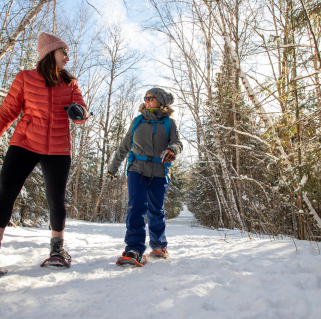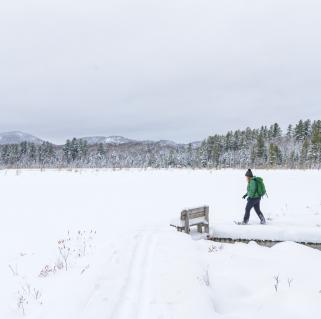Alan Belford
March 26, 2015
A Crew of Students from Syracuse
The birding club from SUNY-ESF in Syracuse came up this past weekend to look for Adirondack birds with me. I teach Field Ornithology courses for ESF at Cranberry Lake Bio Station during the summer and I’m always excited to see folks again. We met in Bloomingdale Bog where the group was having difficulty attracting the attention of any Gray Jays near the feeders. So we walked south in the lightly falling snow to see if that would aid our efforts to draw in the inquisitive jays. We didn’t see any, but we did find Black-capped Chickadees, Common Ravens, and a Red-breasted Nuthatch. Wren raced up and down the trail chasing snowballs and sticks thrown by the students and otherwise exploring everywhere with her nose on the ground.
Feeding Gray Jays
We eventually turned around and as we approached the feeders, the Gray Jays spotted us and came in. Initially there were just two jays, but after we stood there feeding them for a while, their numbers grew to five or six birds. The club members took photos of the jays sitting in the trees and attempted selfies as they fed both the Gray Jays and Black-capped Chickadees while Blue Jays called from nearby – likely trying to find where the Gray Jays cached their goodies. We finally left the area and headed to Bigelow Road.
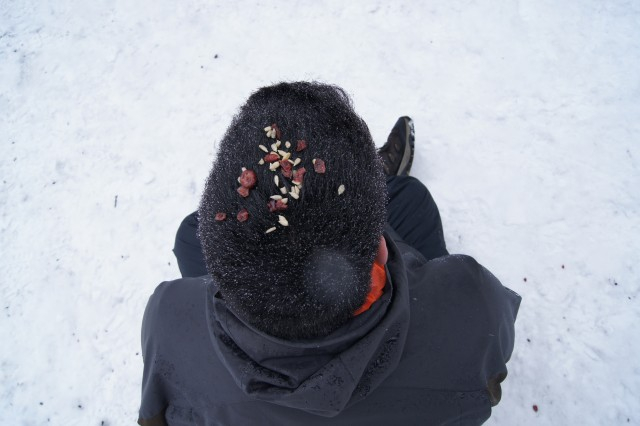
Bigelow was largely quiet, save a few Ravens, Black-capped Chickadees, and a Brown Creeper. We walked, stopping every now and then to listen, and I gave a few Barred Owl hoots to see if I could agitate a response from a Black-backed Woodpecker, but overall things were still – that is except Wren’s racing in every which direction. She loves the ESF students and I think the day out with them was the highlight of her entire winter. She and I returned a few days later to explore Bigelow – finding Gray Jays and a couple Ruffed Grouse.
Tracking Down a Boreal Chickadee
We abandoned Bigelow after a short walk and drove slowly along Oregon Plains Road in hopes of boreal birds we had missed while walking. A short distance along the road I heard the nasal call of a Boreal Chickadee and our caravan quickly pulled over, stopped, and got out – but only found the breeze in the trees. The bird had evidently moved away from the road. We started back up and perhaps two hundred meters further along the road I heard it again – and this time the other passengers in my car heard it too. At least if we didn’t see the bird again this time I wouldn’t look like I was crazy or delusional with the calls of Boreal Chickadees bouncing around in my head. But there was no need for such concerns. This time the bird stuck around just long enough for everyone to get a look at it as it hung from the branches near the tops of the trees along the road. It soon zipped back from the road and we never saw it again. Everyone was happy all the same – it was a life bird for many folks in the group.

After a brief stop along the Gabriels Powerline Trail, where we were hoping again for a Black-backed Woodpecker, we headed into town for some food, keeping our eyes open for the Bohemian Waxwings which have been frequenting various fruiting trees all over town of late. I had seen them as I drove to meet the group that morning. But like most of the birds on this sleety day, they were difficult to initially find and I finally dropped the group off to grab lunch at the Lakeview Deli while I cruised around town to track down the waxwings with a few folks who had already eaten.
A Flock of Bohemian Waxwings
We found the waxwings along Kiwassa Road, and I dropped those with me off while I went to get the others. Once again the birds were new to many of the club members and they stood taking photos as the waxwings dropped from tall, deciduous trees and fed on the remaining low fruit. While they were enjoying the Bohemians, folks also found a flock of Common Redpolls which included a few Pine Siskins, making the stop even more productive.
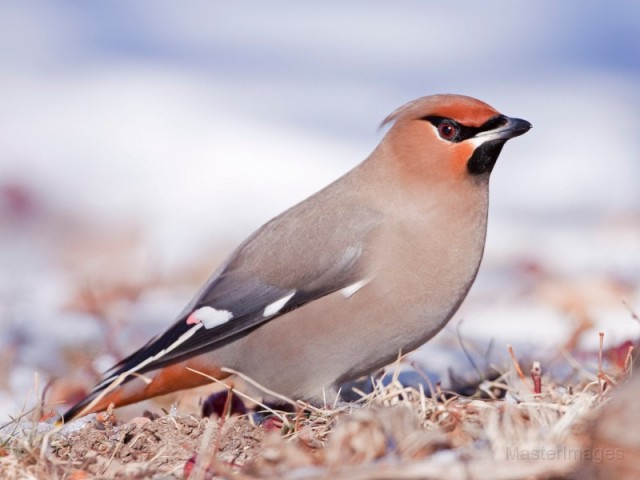
We finally loaded back up to eat unfinished lunches and to head north towards Plattsburgh and Lake Champlain. We would complete our day looking for migrating ducks in the gradually opening waters of the lake, while Wren endured the spa treatment of getting her back scratched and ears rubbed by folks the entire way.
For those looking for birds in the Saranac Lake area, late winter and early spring can be a productive time of year. Check out the dining, lodging, and birding pages for more details on how to plan your trip.

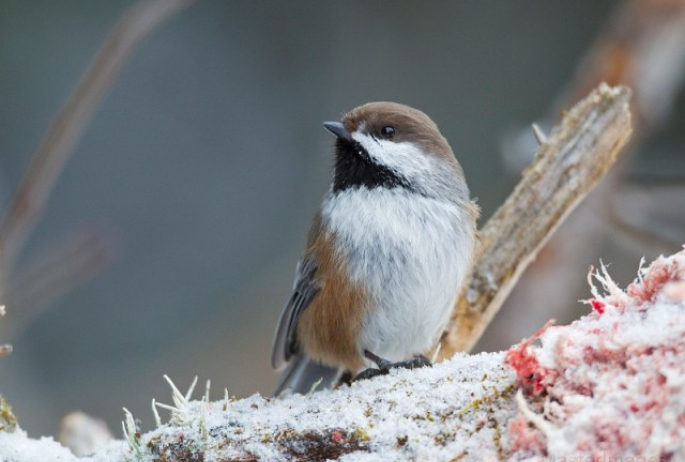
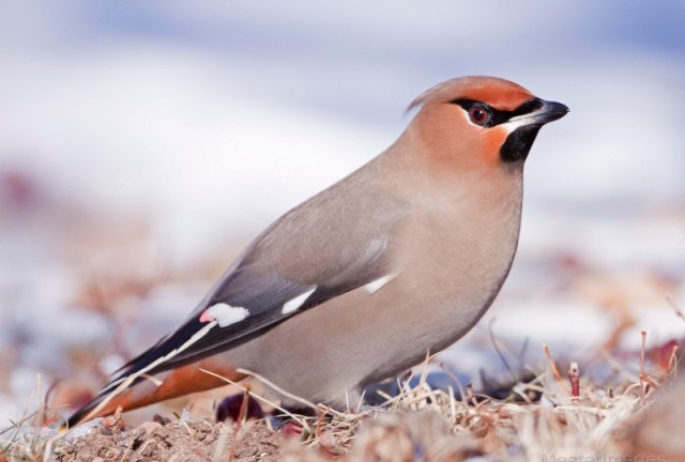
Packages and Promotions
Valid Jan. 16
- Mar. 31
Valid Jan. 16
- Mar. 31
Hotel Saranac Sled & Spoke Package
Hotel Saranac
Snowmobile Package Hotel Saranac and Sara-Placid Sled & Spoke have partnered so you and a guest can explore dozens of miles of ADK snowmobile...
Valid Jun. 20
- Sep. 7
Valid Mar. 12
- Jun. 30
Guided Nature Immersions - 10% off for Pre-Season Registration
Adirondack Riverwalking & Forest Bathing
Picture it now...you are wading the Ausable River on a warm summer day, feel the cool water against you, hear the sounds of the birds and the...
Valid May. 1
- Oct. 31
Valid Dec. 6
- Nov. 1
Zip and Whip Expedition
Farmhouse UTVs
Experience Outdoors and Farmhouse UTVs have teamed up to bring your family and friends the Adirondack adventure you've been waiting for....
Valid Jan. 21
- Mar. 31
Valid Jan. 21
- Mar. 31
Titus Mountain Ski Package
Voco Saranac Lake
Enjoy your stay at the award winning voco Saranac Lake which includes two adult lift tickets at Titus Mountain Family Ski Center. Additional...
Valid Jan. 16
- Mar. 31
Valid Jan. 16
- Mar. 31
Hotel Saranac Ski & Stay Package
Hotel Saranac
Stay & Ski Package Stay at Hotel Saranac and Ski Titus Mountain Day or Night Package Your room reservation includes one adult lift ticket....
Valid Dec. 1
- Dec. 1
Valid Dec. 1
- Dec. 1
Linger Longer in Saranac Lake
Best Western Saranac Lake
Linger Longer in Saranac Lake at our supremely located property, Best Western Saranac Lake. Stay 2 nights or more and get 15% off!
Valid Jan. 21
- Jan. 21
Valid Jan. 21
- Jan. 21
Stay and Dine
Voco Saranac Lake
Receive a 50 dollar credit per stay to use in our Boathouse Saranac Lake Pub. Enjoy an exceptional dining experience with unparalleled views great...

